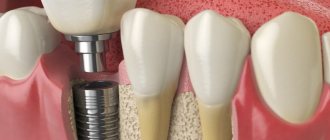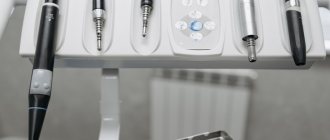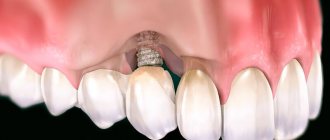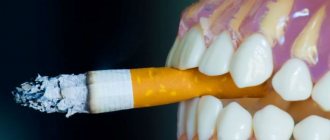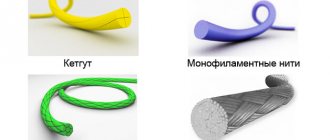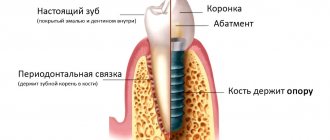All patients strive to spend as little time as possible in the dentist's chair, regardless of what manipulations the doctor performs. But, if we are talking about such an operation as the introduction of an artificial root into the jawbone, questions about the timing are asked especially often. Many people, even at the initial consultation stage, are interested in how long it takes to place a dental implant, believing that such a procedure lasts a long time.
Before answering this question, let us briefly dwell on the actions that a dental surgeon performs during such an intervention.
What manipulations are performed when installing an implant?
The main steps when using the classical technique:
- Introduction of an anesthetic drug.
- Cutting the gums and peeling off the mucoperiosteal flap.
- Formation of the bone bed, with its gradual expansion until the desired size is achieved.
- Periodic irrigation of tissues to prevent overheating of the bone.
- Screwing a metal implant into the hole and installing a plug.
- Placement of mucoperiosteal flaps and suturing.
What happens if the implant does not take root?
Implant failure is difficult to prevent. The causes of the pathology may be peri-implantitis, smoking, non-compliance with medical recommendations in the early and late postoperative period. If acute rejection occurs, removal of the titanium rod is indicated. Re-implantation is possible only after complete healing of the wound. Rejection can develop several years after the permanent crown is installed. A number of external and internal factors can provoke a pathological process and destabilization of the implant.
How long does it take to install a dental implant?
The above manipulations take a total of about 25–35 minutes. But in complicated cases, implant installation is somewhat delayed and can last 40–50 minutes or even an hour.
Also, the operation takes longer if additional combined manipulations are performed. For example, the bottom of the nasal sinus is raised to increase the space for the implant.
The duration of the operation may also increase if the dentist does not yet have much experience in performing such interventions. A highly qualified specialist who has been successfully installing implants for a long time does it quite quickly.
Preparatory stage of implantation
The preparatory stage before implantation is carried out for two purposes: to choose the most suitable type of treatment and to check the possibility of carrying out the procedure in principle. At this step, diagnostic procedures are performed:
Based on the results of objective examinations and instrumental examination data, a decision is made on the need for additional preliminary procedures. What could it be:
- treatment of caries, pulpitis (implantation is a serious intervention, and any inflammation can aggravate its implementation);
- removal of adjacent teeth;
- osteoplasty (compensation for bone deficiency, carried out using sinus lifting, bone grafting or directed regeneration).
What are the fastest ways to install an implant?
Three modern methods of dental implantation require the least amount of time:
- One-step. A single-rooted tooth that cannot be restored can be quickly removed and replaced with an implant and crown. In this case, the rod is screwed into a ready-made hole. Therefore, such an operation can take only 15 minutes.
- According to the template. A navigation surgical template helps reduce the time of implant installation. This is a plastic structure with guide holes. Through them, the dentist prepares a bed for the implant, for which mills with depth limiters are used. The screw rods are quickly screwed into the prepared holes. Since the gums are not cut or sutured, installation of one element takes no more than 20–25 minutes.
- Express implantation. Implants are installed quickly also using one-stage All on 4(6) protocols. The rods are screwed into the bone through the gums, without any soft tissue incisions. Only small punctures are made through which the dentist inserts implants into the jaw. This operation takes from one and a half to two to three hours, depending on the number of rods being installed.
When installing an implant, it is not the duration of the operation that is important, but the quality. If the doctor has the appropriate qualifications, experience, is not in a hurry and does everything in accordance with the protocol, the procedure takes exactly as long as necessary.
How long can you wear implants without crowns?
If we consider a two-stage implantation protocol, then you will have to walk without permanent crowns for six months. To restore the aesthetics and chewing function of the dental system, temporary plastic crowns are fixed 2-3 months after surgery.
Permanent crowns are installed only after successful osseointegration of the implant into the bone tissue. Temporary crowns should be worn not only for aesthetics, but also to prevent atrophy of the bone tissue of the jaw arch and destabilization of the titanium rod.
Advantages of using innovative technologies
Dentistry has been actively developing and undergoing significant changes in recent years. Innovative technologies have become available to patients, making the process of dental restoration safer, faster, more reliable, more comfortable and of higher quality.
Such technologies include:
- CAD/CAM system. This is an abbreviated name for modern computer technology: where CAD - Computer-Aided Design - means design using computer programs, CAM - Computer-Aided Manufacture - production using computer technology.
The system makes it possible to automate all stages of the manufacturing process of an orthopedic structure. - Three-dimensional prosthetics (3D). It involves the inclusion of high-precision computer technologies in all stages of prosthetics, starting from diagnosing the condition of the dental system, ending with the development and creation of a prosthesis.
- CEREC system. This is a computer technology, the peculiarity of which is the production of a prosthetic structure directly in front of the patient’s eyes, i.e. in one visit to the clinic.
- Nobel Procera . Computer technology makes it possible to produce biocompatible, high-precision, ideal in functionality and aesthetics, durable prostheses.
The demand for new technologies in dental prosthetics is constantly growing. Their popularity is explained by a number of significant advantages:
- The patient's time is saved, i.e. The duration of the entire recovery process and the number of planned visits to the doctor are reduced.
- Cash costs are reduced due to the absence of payment for performing bone grafting in case of insufficient jaw bone volume and a reduction in clinic visits.
- The rehabilitation period is shortened and easier.
- There are no risks of complications associated with inaccurate fit, unnecessary trauma, damage to nerves and the maxillary sinus.
- The end result can be visualized, i.e. The patient can view the progress of prosthetics on the computer and see the result.
- Based on the complexity of the case, you can select the optimal prosthesis model or accurately determine the safe place for inserting the implant.
- Tissue trauma is minimal.
- Automation of the manufacturing process of prosthetic structures helps make them accurate and comfortable.
- The human factor is excluded.
Diagnostics
Diagnostics is a mandatory procedure in the therapeutic stage of preparation for prosthetics.
Its purpose is to determine the quality and thickness of the jaw bone, the condition of dental roots and canals, identify pathologies that occur in a latent form, and study the features of the bottom of the maxillary sinus and maxillary sinuses.
The results of diagnostic examinations are needed to determine the indications (limitations) for prosthetics, choose the method of tooth restoration and the type of prosthetic structure.
Thanks to a comprehensive study of the dental system, it is possible to prevent complications and extend the life of the prosthesis.
Today the therapeutic stage practices the following types of research:
- CT scan (CT).
An informative diagnostic method that allows you to obtain an accurate three-dimensional image of the patient’s dentoalveolar apparatus, by which the doctor can identify hidden anomalies, assess the condition of the alveoli, check the quality of the jaw bone, and determine root defects.The image is clear enough and can be viewed in all projections and enlarged (if necessary), which has a positive effect on the accuracy of drawing up a treatment plan.
The average duration of a scan is no more than 10 seconds, plus you need to add time for the doctor to draw up a card, prepare for the procedure, position the device, and print out the result.
Computed tomography is convenient for that category of people who have permanent metal prosthetic structures.
- Orthopantomogram.
This is one of the common types of x-ray examination, otherwise known as a panoramic image (with two-dimensional visualization).The orthopantomogram shows a clear picture of the condition of the entire dentofacial apparatus, i.e. Using the image, you can not only study the condition of all remaining teeth, the temporal joint and the jaw bone (its density and volume), but also determine the distance to the maxillary sinuses, consider their condition and location.
A panoramic image also helps to create a correct and competent treatment plan. The duration of the diagnosis is no more than 15 minutes, the image is taken within 5 minutes.
- MRI (Magnetic resonance imaging).
A diagnostic method used to determine the presence of hidden pathologies of the dental system, determining the quality and condition of tissues.Among the advantages is the ability to obtain a clear 3D image without distortions and errors with increased contrast, which allows you to study in detail the area of the proposed restoration. The average duration of the examination is about half an hour.
- Radiovisiography.
This is an X-ray diagnosis of the condition of the dental system, displaying the result on several or one targeted image.They are used both for the study of a single dental element and its roots, and for diagnosing the condition of the periodontal tissues and jaw bone. The approximate duration of the process is 7-10 seconds.
Important! The doctor decides which diagnostic method will be prescribed, based on the characteristics of the clinical case and the scope of the upcoming treatment.
It is impossible to accurately indicate the duration of the clinical stage - it all depends on the age of the patient, his state of health and the duration of obtaining the result, i.e. from 1 day to 10 days (if you wait for the result for HIV infection).
Contraindications
- Early childhood and adolescence
- Blood diseases in which clotting is impaired
- Severe uncontrolled diabetes mellitus
- Advanced tuberculosis
- Severe osteoporosis
- Serious endocrine disorders
- Oncological processes in the acute stage
- Intolerance to anesthetic drugs
- Serious central nervous system disorders
- Chronic alcoholism, drug addiction
- The patient does not follow the recommendations for care
Temporary contraindications to surgical intervention are the unsatisfactory condition of the gums and enamel, pregnancy, periods of exacerbation of chronic diseases, colds and flu.
Thanks to the development of technology, the installation of dental implants has become available to patients with hepatitis and diabetes, and people with reduced immunity. When using low-traumatic techniques, the procedure is allowed for elderly patients.
Recommendations after surgery
In the postoperative period, the patient must follow the doctor’s recommendations:
- You should not eat food for three hours after the procedure. Then warm soup or yogurt, soft cottage cheese, and mashed boiled vegetables are recommended.
- For the first three days, too cold or hot food is recommended. The diet must be expanded gradually. Hard foods create stress when chewing and should be temporarily avoided.
- While eating, try to minimize the mechanical impact on the wound area, give up the habit of chewing a pencil.
- Replace coffee and black tea with herbal or fruit compote.
- Avoid smoking, alcohol, and heavy physical activity.
- The diet should include a sufficient amount of fluid and foods rich in calcium, vitamins P and C.
- To reduce swelling, use cold compresses on the cheek or ice, wrapped in a towel.
- Painkillers prescribed by your doctor will help eliminate the discomfort.
What to do to prevent rejection:
To prevent peri-implantitis, take proper care of your oral cavity and take antibiotics for seven days. Do not touch the seam area with your hands or tongue! For up to 3-4 days after the procedure, you need to make oral baths with an antiseptic solution. When the swelling decreases, it is recommended to rinse your mouth gently. Start brushing your teeth no earlier than the fifth day after surgery. Use the paste to prevent gum inflammation. Please note: it is better to use a new brush with soft bristles!
During the rehabilitation period, avoid sports training, sauna visits, overheating and hypothermia, and air travel. If the procedure was performed using a sinus lift, you should cough and sneeze with caution. You can’t puff out your cheeks too much or open your mouth wide.
Service life and guarantees of the clinic
The service life of the implant depends on the professionalism of the doctor and the behavior of the patient. If you follow the implantologist’s recommendations and use them correctly, the implant will last a lifetime, and the dentures will last up to 20 years.
ROOTT system implants come with a lifetime warranty. The conditions are valid only if the patient follows the rules of oral care. If the implant fails before installing a permanent denture, the titanium root is reinstalled free of charge.
Mandatory monthly check-ups are required for 12 months after surgery. The results are saved in the patient's service book. If the client ignores these requirements, there are no warranty periods.
Be sure to take time for professional oral hygiene. It is shown at least once a year. When a full jaw is implanted in the clinic, the procedure is free of charge.
Choosing where to get treatment
You can choose a dental clinic based on price level, but you just need to make sure that they can help you there. Sometimes it happens that someone’s teeth were inserted poorly, after which complications arose or the result turned out to be unaesthetic. Typically, such patients leave unflattering reviews about a medical institution or a specific doctor. They also write where they went next, and where they managed to fix everything. However, you should not completely rely on these reviews. After all, if a person writes and does not know what kind of doctor he is who inserts teeth, what his specialty is called, then is it worth trusting such assessments? Anyone who actually underwent treatment knows for sure that he consulted an orthopedist or orthodontist, that the prosthesis was made by a dental technician - and this is a different specialist, and that the preparatory work was done by a dental therapist. In small clinics, a doctor can combine the work of an orthopedist and a therapist, but never also act as a dental technician!
So it’s always better to rely on the choice of your friends rather than on the opinion of a stranger who left a review on the site. Such a person could be hired by competitors to ruin the reputation of the dental clinic.
How to insert teeth: methods used today
Everyone is interested in which teeth are best to insert, what materials are used for this, and how long will you have to wait until the dentures or crowns are ready? More inquisitive patients ask: are wisdom teeth prosthetic? It all depends on the specific case. If, for example, you need to insert three teeth – the 5th, 6th and 7th, then the 8th tooth may well become the supporting one. But if only the wisdom tooth itself is lost, then it does not need to be replaced. If a removable prosthesis of chewing teeth is made, then, as a rule, there are no “eights” in it: this is justified, since the amount of work of the dental technician is reduced and, accordingly, the patient’s costs are reduced. The remaining teeth - canines, incisors, molars - are definitely subject to prosthetics.
There are several ways to insert teeth:
- Make a removable denture based on natural or implanted teeth.
- Replace a missing tooth with an implant.
- Place a bridge supported by an implant or natural teeth.
- Install a clasp prosthesis.
- Create a removable denture supported by soft tissue and mucous membrane with complete edentia.
There are also several materials from which crowns and artificial teeth are made. They vary significantly in cost, which allows you to choose prosthetic options for different budgets.
Stock
-47%
Dental implant Osstem 35,000 rub.
18500 rub.
get -20 %
Manufacturing of removable denture Acry Free 40,000 rub.
32,000 rub.
get -9 %
BASAL COMPLEX - Restoration of teeth on 1 jaw in 3 days 330,000 rub.
300,000 rub.
get -10 %
Internal braces Win 200,000 rub.
180,000 rub. get


